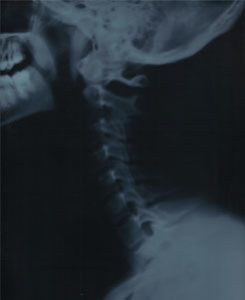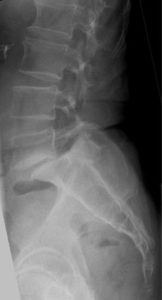COMMON SPINAL CONDITIONS
Cervical Spine
 The cervical spine, consisting of the seven upper-most bones in the spine, begins at the base of the skull. There are several injuries and ailments that effect this area of the human body. These include.
The cervical spine, consisting of the seven upper-most bones in the spine, begins at the base of the skull. There are several injuries and ailments that effect this area of the human body. These include.
Herniated Nucleus Pulposus: When people say they have a “slipped” or “ruptured” disk in their neck or lower back, what they are actually describing is a herniated disk-a common source of pain in the neck, lower back, arms, or legs. Disks are soft, rubbery pads found between the hard bones (vertebrae) that make up the spinal column. The spinal canal is a hollow space in the middle of the spinal column that contains the spinal cord and other nerve roots. The disks between the vertebrae allow the back to flex or bend. Disks also act as shock absorbers. A disk herniates or ruptures when part of the center nucleus pushes the outer edge of the disk and back toward the spinal canal. This can put pressure on the nerves. Spinal nerves are very sensitive to even slight amounts of pressure, which can result in pain, numbness, or weakness in one or both legs.
Radiculitis: Some people have neck pain that may radiate into the shoulder and arm. This type of pain is often caused by an injury near the root of a spinal nerve. A nerve root injury is sometimes referred to as a “pinched” nerve. The medical term for this condition is cervical radiculitis. Cervical radiculitis pain travels down the arm in the area of the involved nerve. Pain is usually described as sharp. There can also be a “pins and needles” sensation or even complete numbness. In addition, there may be a feeling of weakness with certain activities. Symptoms can be worsened with certain movements, like extending or straining the neck or turning the head. These symptoms are often made better by placing the hand on the head and stretching the shoulder.
Cervical Spinal Stenosis: Cervical spinal stenosis is the narrowing of the spinal canal in the neck. The spinal canal is the open area in the bones vertebrae that make up the spinal column . The spinal cord is a collection of nerves that runs through the spinal canal from the base of the brain to the lower back. These nerves allow us to feel, to move, and to control the bowel and bladder and other body functions. In cervical spinal stenosis, the spinal canal narrows and can squeeze and compress the nerve roots where they leave the spinal cord, or it may irritate or injure the spinal cord itself.
Lumbar Spine
 The Lumbar vertebrae are the largest segments of the movable part of the vertebral column. Consisting of five vertebrae, the lumbar region of the spine is the main source of body motion and supports most of the body’s weight. It is commonly associated with the “lower back” region of the body.
The Lumbar vertebrae are the largest segments of the movable part of the vertebral column. Consisting of five vertebrae, the lumbar region of the spine is the main source of body motion and supports most of the body’s weight. It is commonly associated with the “lower back” region of the body.
Herniated Nucleus Pulposus: Sometimes called a slipped or ruptured disk, a herniated disk most often occurs in your lower back. It is one of the most common causes of low back pain, as well as leg pain (sciatica). Between 80-90% of people will experience low back pain at some point in their lives. A percentage of people will have low back pain caused by a herniated disk.
Radiculitus: Some people have lower back pain that may radiate into the buttocks and legs. This type of pain is often caused by an injury near the root of a spinal nerve. A nerve root injury is sometimes referred to as a “pinched” nerve. The medical term for this condition is lumbar radiculitis. Lumbar radiculitis pain travels down the arm in the area of the involved nerve. Pain is usually described as sharp. There can also be a “pins and needles” sensation or even complete numbness. In addition, there may be a feeling of weakness with certain activities. Symptoms can be worsened with certain movements.
Lumbar Spinal Stenosis: Almost everyone will experience low back pain at some point in their lives. A cause of low back pain is lumbar spinal stenosis. As we age, our spines change. These normal wear-and-tear effects of aging can lead to narrowing of the spinal canal. Spinal stenosis occurs when the space around the spinal cord narrows. This puts pressure on the spinal cord and the spinal nerve roots, and may cause pain, numbness, or weakness in the legs.
Degenerative Disc Disease: DDD is not actually a disease for the spine but part of the normal aging process of the spine. The discs in the spine lose their hydration.
Spondylosis: Spondylosis is the degeneration of the joints in the spine. It becomes increasingly more common as people age. More than 85% of people over age 60 are affected. Although it is a form of arthritis, spondylosis rarely becomes a crippling or disabling type.
Instability: The spine has several stabilization systems in place to provide support for the spine. These systems include the spinal column, and the spinal muscles. When the joints in the spine become dysfunction, i.e., gain too much flexion, the spine can destabilize. As a result, there is excess motion in the spine which often leads to clinical. Additional, osteophytes can form to provide stability but actually can lead to additional pain.












